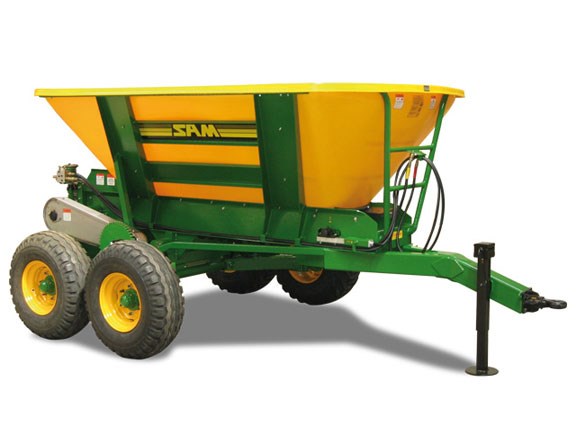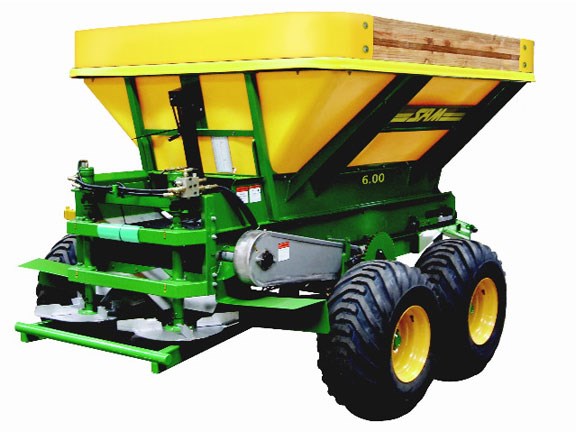SAM Fertiliser Spreader





|

|
SAM spreaders have evolved over the past 60 years to meet the changing demands of farmers and technology

|
|
SAM Fertiliser Spreader
|
- SAM 4, 5 and 6 tonne spreaders now include an 8mm thick UV stabilised polyethylene bin
- SAM spreaders are available with an 800mm wide conveyor belt to cope with ‘heavy’ material
- Via an electronic readout, weigh scales inside the spreader display the exact fertiliser quantity inside the hopper
- Clear signs display the location of each grease nipple so none are missed
Both spinners operate off the tractor’s hydraulic system, at a pre-set 850rpm. From the hopper, chemical-based fertiliser is fed via a standard 400mm wide conveyor belt, where the correct quantity is controlled by a manually adjustable outlet door (40kg to 2500kg per hectare), with an easy to follow chart for each of the common fertiliser types, lime, superphosphate and urea.
Each pass is set for a 15m spread range for superphosphate fertiliser.
Dave Meade operations manager fro Coombridge and Alexander, says SAM’s vast experience has found the position of the dropped fertiliser onto the spinners is critical for a good, consistent spread pattern.
Tractors will need to deliver at least 35 litres per minute of hydraulic flow rate to drive the hydraulics (when set in series) on any of the SAM Spreader models.
In-paddock, the tractor operator activates an in-cab hydraulic switch that moves a simple gear mechanism positioned off a RH wheel into place, via an auto-clutch. The spreader conveyor travels according to the ground speed to lay down the correct volume.
The four-tonne SAM spreaders can be purchased in either single- or tandem-axle configurations. Moving up the product line are the five-tonne and six-tonne options, which have become available the past four years for larger farms and contractors, both tandem axle units. The largest is an eight-tonne spreader with big-wheel tandem axles, for the contractors.
"The most popular model is still the four-tonne tandem axle machine, it’s a good farm sized unit that will hold four tonne of superphosphate or six tonne of lime, and the tandem axle machine is what most farmers use," Meade explains.
"If things are very wet, a big single tyre [approx 800mm diameter] is a better option over a tandem axle, but a tandem axle is a very smooth machine. It tows very well and doesn’t bounce, so the tandem will grip better on the hillsides, you’ll always have rubber on the ground."
A growing demand is now coming from organic farmers, who typically spread different types of fertiliser onto their soils, including pig or poultry manure. To cope with this type of heavy ‘product’, SAM spreaders are available with an 800mm wide conveyor belt to let the manure flow better out of the hopper and into the spinners.
A new development incorporates weigh scales inside the spreader. Via an electronic readout, the load scales will display to the farmer or contractor the exact fertiliser quantity inside the hopper. The display can even be connected to an in-cab hectare meter to further fine-tune the spread via the consumption rate.
Around 1990 the SAM colours were changed from red to the present day yellow and green colour scheme. In 2005, 8mm thick polyethylene hoppers were introduced onto the SAM spreaders to give the units a longer and more reliable life, and taking away the chance of the hopper rusting.
All of the internal panels, skirts and deflectors are made of long-lasting stainless steel, and the conveyor mat is well designed for optimum tension and tracking.
See SAM spreaders for sale here.
Read in-depth farm machinery reviews in the latest issue of Farm Trader magazine, on sale now.
Keep up to date in the industry by signing up to Farm Trader's free newsletter or liking us on Facebook



.jpg)



.jpg)
.jpg)
.jpg)

